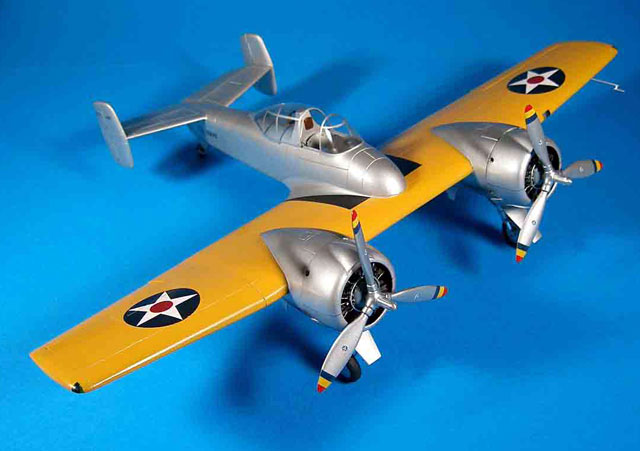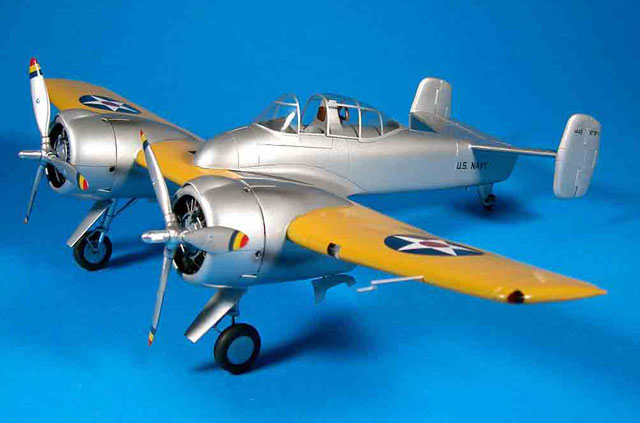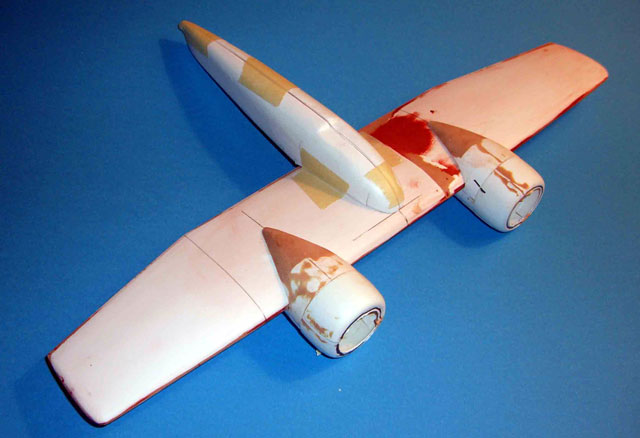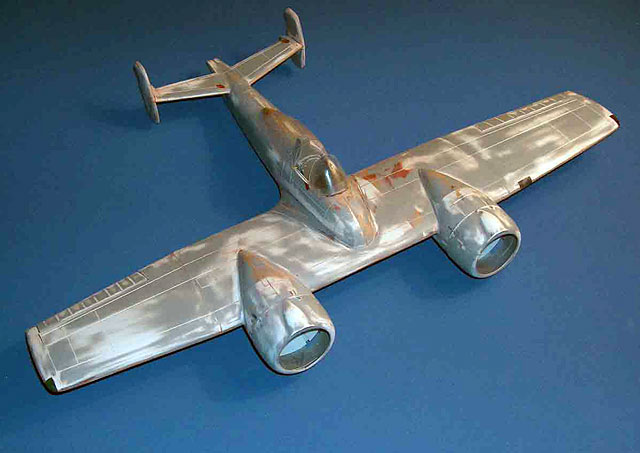|
Scratch built 1/32 scale
Grumman XF5F-1
by Frank Mitchell
|
 |
|
Grumman XF5F-1
|

HyperScale is
proudly supported by
Squadron
Background
I suspect that many modelers would list
this airplane among their favorites, if not for its unique
configuration, then for its attachment to the comic book capers of the
Blackhawks, a fictional group of pilots who had great adventures while
doing Good Works.
The aircraft began as a proposal from Grumman to the Navy, which issued
a contract for the one-and-only prototype in June, 1938. The aircraft,
designated as the XF5F-1, had a span of 42 feet and was powered by two
contra-rotating 1,200 horse power Wright Cyclones.
Like most prototypes, the aircraft went through a variety of
modifications to address the difficulties that appeared. For example,
the Skyrocket was overweight, showed some structural weakness in the
landing gear, and suffered from engine overheating (interestingly, the
left engine always ran hotter than the right). These and other problems
eventually led to the addition of an extended forward fuselage, extended
fuselage nacelles, spinners, and other alterations. The Navy test pilots
loved the torque-free engines and praised the prototype’s general flying
qualities, but did complain about a lack of visibility in some
conditions.

The Skyrocket was certainly not the failure that many people thought,
and maybe still think, it was. In 1941 it took part in a fly-off against
the Spitfire, Hurricane, P-40, P-39, Airabonita (navalized P-39), XF4U
Corsair, F4F Wildcat, and F2A Buffalo. The analysis of all the data
definitely favored the F5F, with the Spitfire coming in a distant
second. The officer commanding the trials noted that the XF5F simply
pulled away from the Corsair on a climb to 10,000 feet. However, given
the world situation at the time and other problems including more
difficult construction and the need to acquire more parts for the twin-engined
configuration, the Navy settled on the Wildcat for its fighter
production.
The XF5F-1 had a long life of over 5 years during which it was used to
gather data for what would become the F7F Tigercat. In addition, it led
to the construction of the XP-50, a version planned for the USAAF which,
after being destroyed in a crash early in its career, was not further
developed.
It was adopted by the fictional
Blackhawks in 1941 and remained a part of the story until 1949. The
artist of the strip, Charles Cuidera, changed the configuration as time
wore on to include in-line engines and a single vertical tail.
The Model
I had long thought about doing a
Skyrocket. After all, it was a prototype and was a bit weird in
appearance, both alluring to me.
Besides, it looks cool.
Therefore, after about 40 years of
thinking about it, I decided to take a shot.
I had gathered a lot of information over the years on the airplane, but
pretty much all of it recently appeared in the Ginter book on the
Skyrocket. One problem was that none of the several sets of plans I had
(including a set of original Cleveland model plans) were without some
problems, so I ended up using a combination of several of them plus a
few additions based on just looking long and hard at every picture I
could find (a strategy I strongly recommend).
Construction,
Painting and Markings
|
The techniques used in the model were
essentially the same that I use for all my models and which you are
probably sick of hearing about, so I will just hit the high spots, and
let the photos tell the story.

Basic construction was balsa molds vacuum-formed using .030 styrene. The
wood was left inside for strength and to make the attachment of wings,
tail, nacelles, etc., much easier. Landing gear was made from brass and
aluminum tubing, and the engines were a set of Vector Cyclones. The
props came from some long-forgotten model that ended up in the scrap
box. The wheels, along with some photo-etch and a number of other small
pieces, came from a friend’s derelict Revell Wildcat. The canopy was
formed from clear vinyl over a carved balsa mold covered with two coats
of 30-minte epoxy that was sanded and polished.

Click the
thumbnails below to view larger images:
[../../photogallery/photo00012191/real.htm]
The model represents the aircraft in its
second configuration, which involved cleaned-up cowlings, modified prop
“spinners”, wing fillets, and modified landing gear doors.

Although it took great restraint to not apply Blackhawk markings, the
paint finally used was Gunze, covered with Future. After Yellow Wings
stars were applied, the wing was again coated with Floquil Flat Finish
(it was just too shiny).
Still one of my all-time favorite
aircraft.
Click the
thumbnails below to view larger images:
[../../photogallery/photo00028909/real.htm]
Model, Images and Text Copyright © 2007
by Frank Mitchell
Page Created 23 May, 2007
Last Updated
24 December, 2007
Back to
HyperScale Main Page |
Home
| What's New |
Features |
Gallery |
Reviews |
Reference |
Forum |